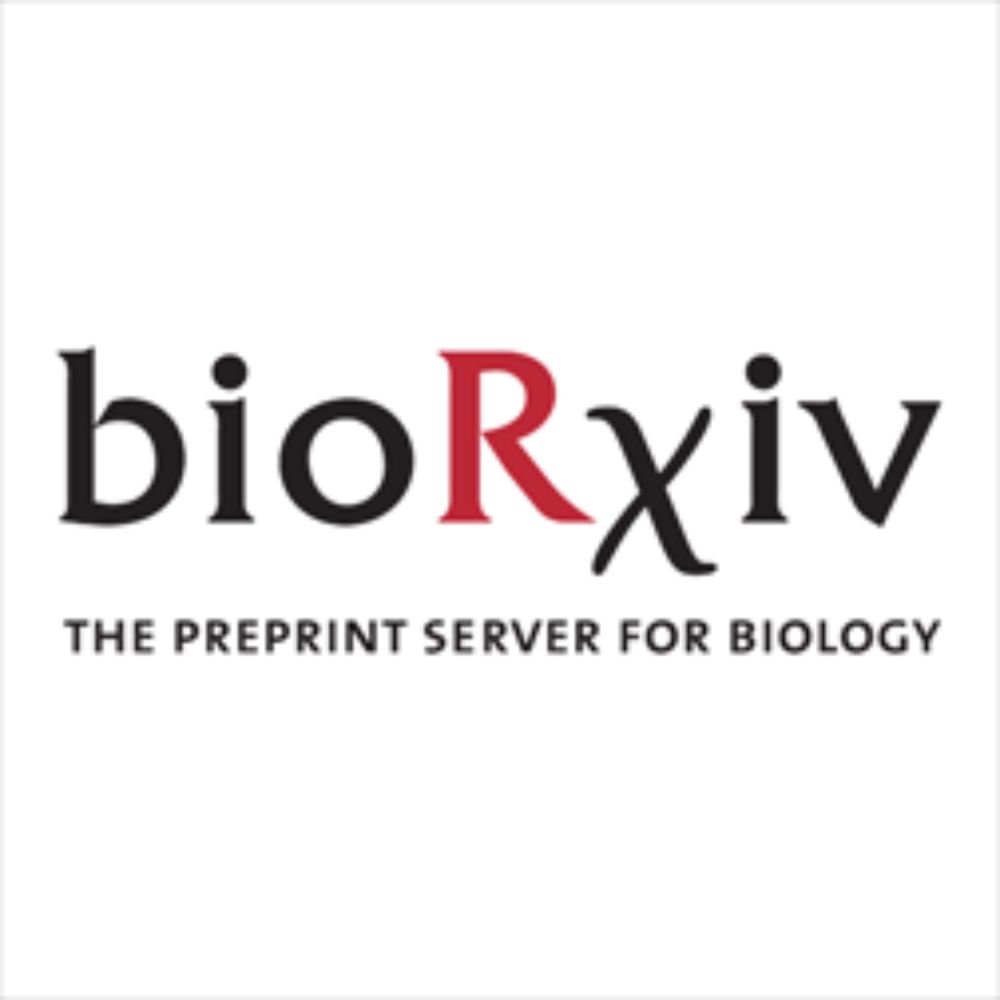16/16 This work was a big team effort and fun collaboration! Thanks to everyone: Matt, Egill, Tanner, Jing, Zaofeng, Americo, Florian, Hamna, Ryan, Nick, Israel and our stellar mentor Sam for making this project possible!
24.07.2025 19:58 — 👍 0 🔁 0 💬 0 📌 0
15/16 In summary, we shed light on the biological role of a naturally occurring version of CRISPR interference (CRISPRi), that emerged in gut-associated bacteria to benefit multiple aspects of their lifestyle.
24.07.2025 19:58 — 👍 0 🔁 0 💬 1 📌 0
14/16 The repeated exaptation of TnpB to regulate flagellin suggests strong evolutionary pressure favoring RNA-guided control of flagellin expression, particularly in gut-associated bacterial species.
24.07.2025 19:58 — 👍 0 🔁 0 💬 1 📌 0
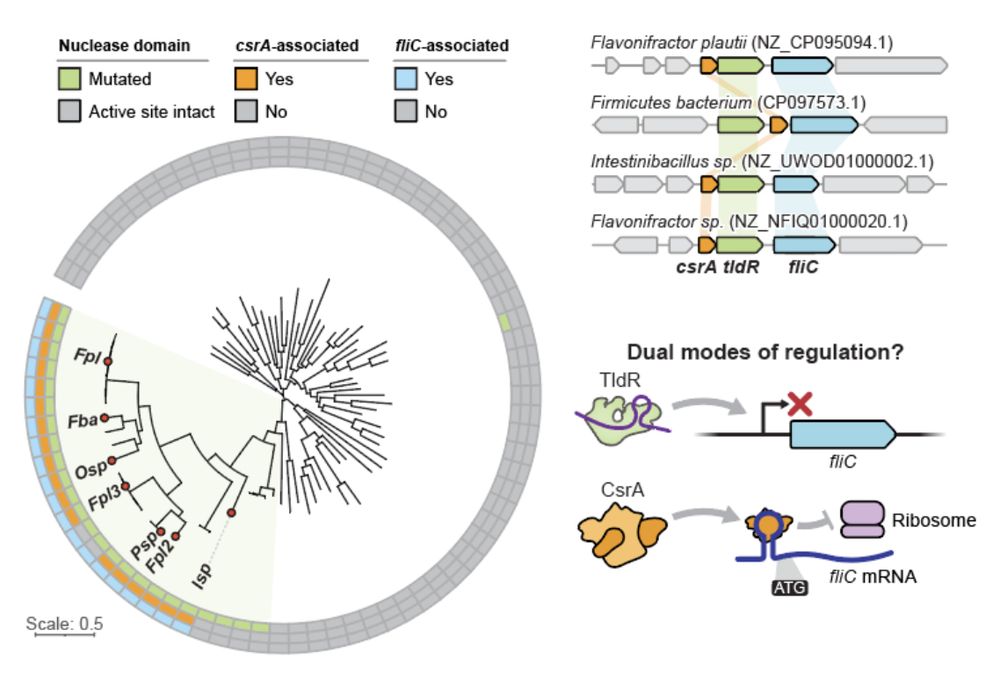
13/16 In other key members of the human gut microbiome, flagellin-regulating TldRs can be found additionally associated with the translational repressor CsrA. The coordinated action of TldR and CsrA suggests a dual mode of both transcriptional and post-transcriptional gene regulation.
24.07.2025 19:58 — 👍 0 🔁 0 💬 1 📌 0
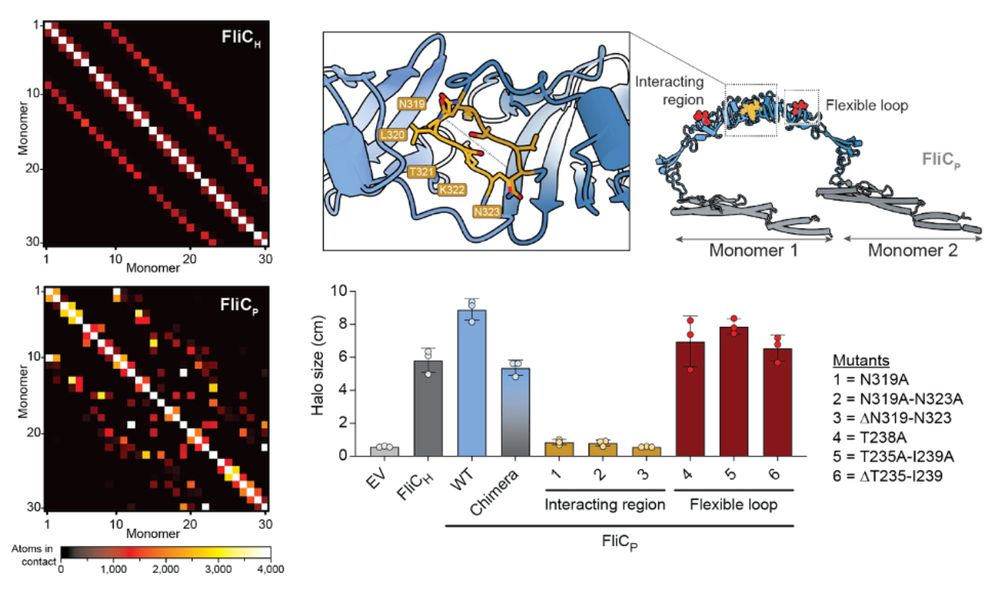
12/16 The extra domain stabilizes the filament by increasing inter-subunit contacts. Structure-guided mutagenesis confirmed that this domain is essential to improve motility of the lysogen. We believe it could similarly explain the decreased activation of TLR5.
24.07.2025 19:58 — 👍 1 🔁 0 💬 1 📌 0
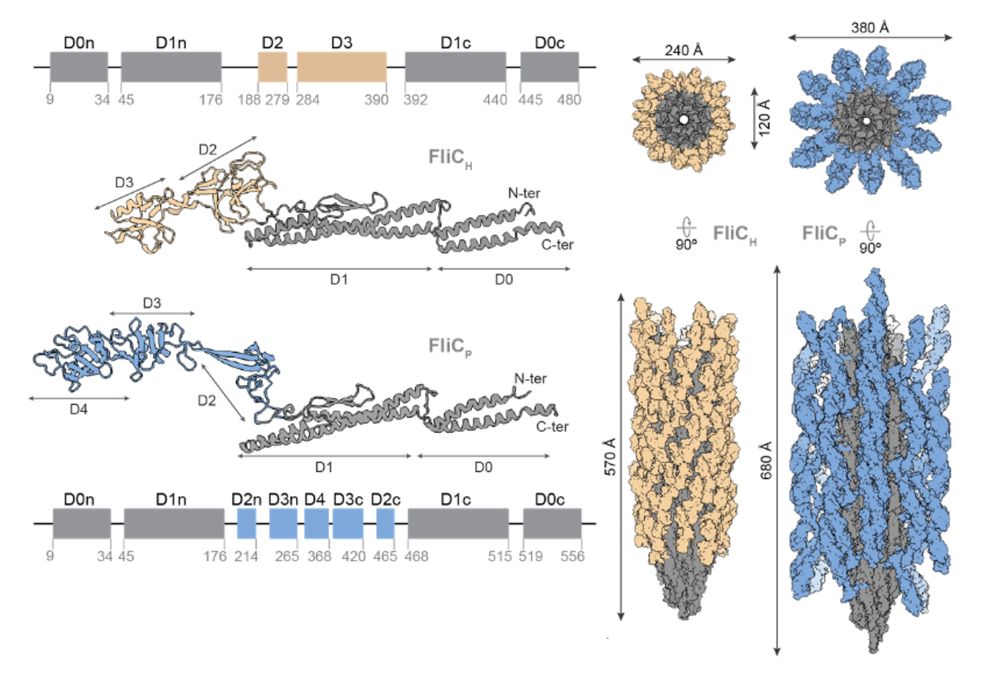
11/16 We found that both flagellar filaments have a drastically different structure. The prophage flagellar filament is significantly thicker and presents a surprising mesh-like structure. This is due to the presence of an extra domain in the prophage flagellin.
24.07.2025 19:58 — 👍 1 🔁 0 💬 1 📌 0
10/16 To try to link these phenotypic observations, we teamed up once again with @piratefernandez.bsky.social and decided to inspect the structures of the prophage flagellin in comparison to their host counterpart.
24.07.2025 19:58 — 👍 0 🔁 0 💬 1 📌 0

9/16 The phenotypic effects of lysogenization result in a consequential ecological outcome: enhanced colonization of the murine gut, illustrating the advantage of flagellar remodeling in a host-associated environment.
24.07.2025 19:58 — 👍 0 🔁 0 💬 1 📌 0
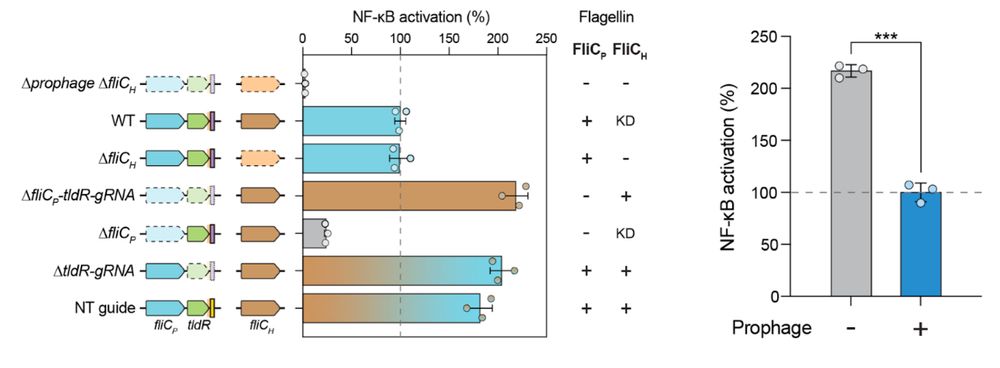
8/16 We also find that lysogenic conversion by FRφ reduces activation of TLR5, a receptor that detects flagellin to initiate the immune response, suggesting that lysogenization may facilitate immune evasion.
24.07.2025 19:58 — 👍 0 🔁 0 💬 1 📌 0
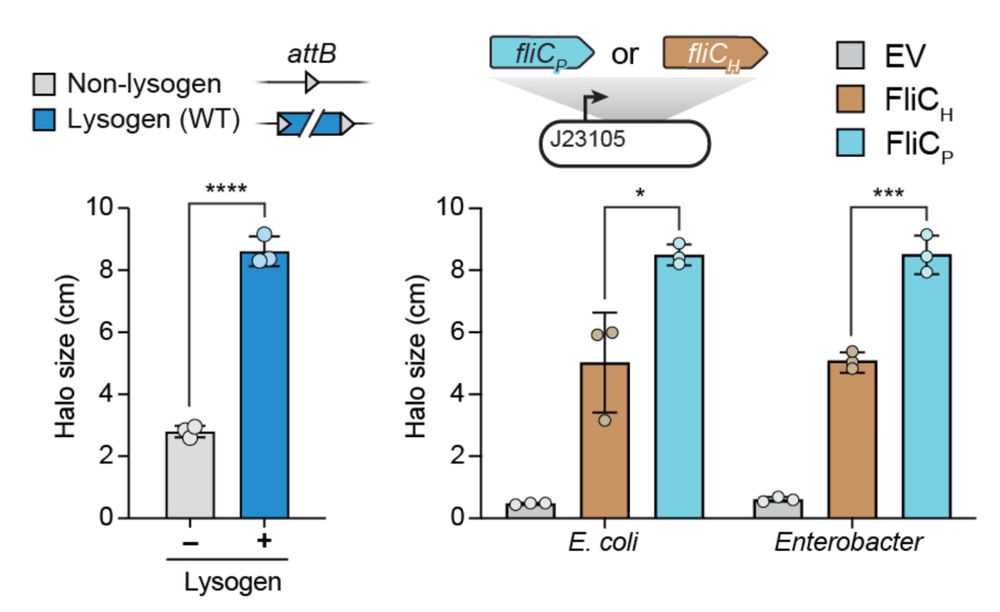
7/16 We find that lysogenic conversion by FRφ leads to increased motility of the host. Essentially, Enterobacter (and even E. coli actually) swims faster when expressing FliCp instead of FliCh.
24.07.2025 19:58 — 👍 0 🔁 0 💬 1 📌 0
6/16 To tackle this question we focused on a clinical isolate of Enterobacter, that natively contains what we now call a Flagellin Remodeling prophage (FRφ), and started our detective work to uncover the potential advantage(s) conferred by the acquisition of this prophage.
24.07.2025 19:58 — 👍 0 🔁 0 💬 1 📌 0
5/16 Prophages sometimes provide new traits to their bacterial host, that is called “lysogenic conversion”. Now, why would a phage manipulate the flagellar apparatus of their host? That question is the focus of our new study.
24.07.2025 19:58 — 👍 0 🔁 0 💬 1 📌 0
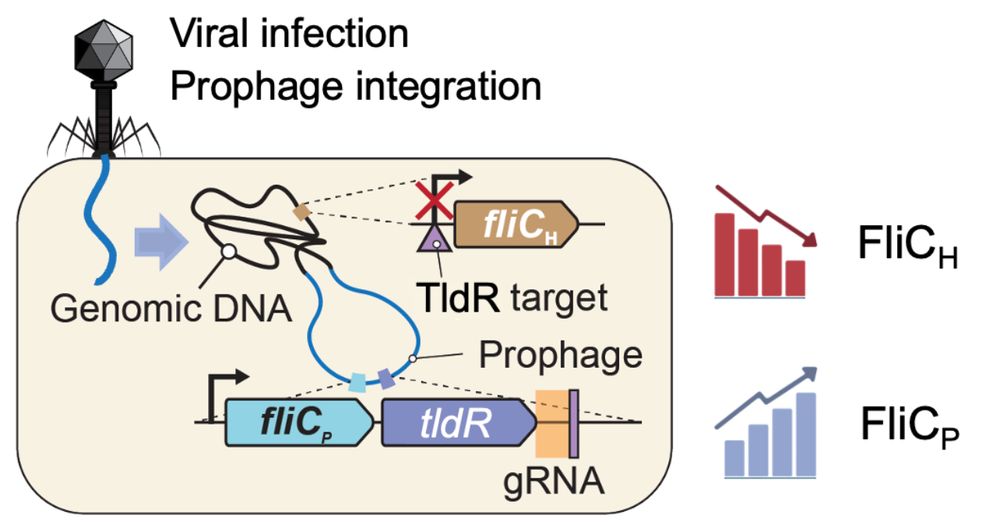
4/16 Strikingly, FliC-associated TldRs are found in prophages and target the promoter of host-encoded FliC. Basically, TldR silences the host FliC (FliCh) and the prophage copy (FliCp) takes over, effectively leading to a remodeling of the host flagellar apparatus.
24.07.2025 19:58 — 👍 1 🔁 0 💬 1 📌 0
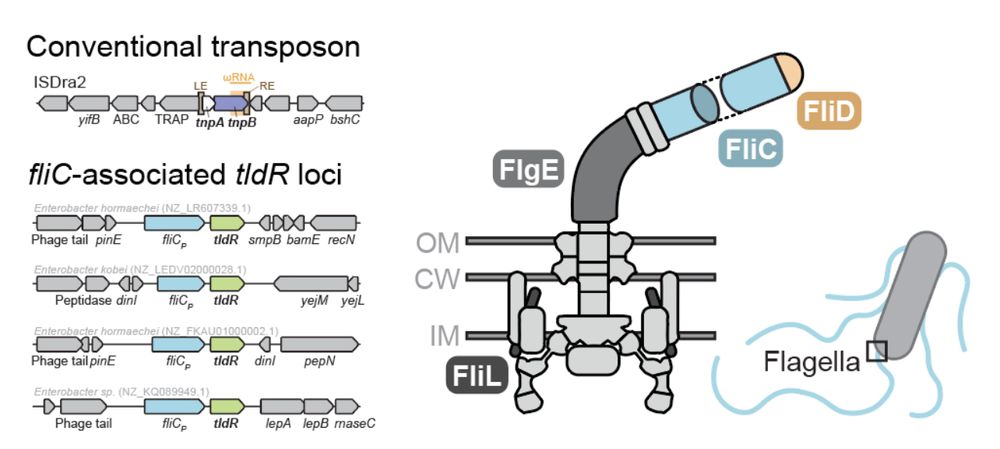
3/16 Unlike TnpB, which can be found in transposons and in association with transposases, TldR is often found in association with FliC (flagellin), the main subunit of flagellar filaments. Flagella are large appendages used by bacteria for motility.
24.07.2025 19:58 — 👍 1 🔁 0 💬 1 📌 0

2/16 Last year we reported the discovery of RNA-guided transcriptional repressors, derived from the Cas12 ancestor TnpB. We called it TldR for “TnpB-like nuclease dead repressors”. Yet, we did not address their actual biological role.
More details here: tinyurl.com/2camf88e
24.07.2025 19:58 — 👍 0 🔁 0 💬 1 📌 0

1/16 New pre-print from the Sternberg Lab!
We uncover how temperate phages can use RNA-guided transcription factors to remodel the flagellar composition of their bacterial host and enhance their fitness.
Find the preprint and full story here: tinyurl.com/mshwjd77
24.07.2025 19:58 — 👍 69 🔁 35 💬 3 📌 1

Q&A: One scientist’s bold vision to make on-demand treatments routine for life-threatening rare genetic diseases
Broad core member and gene editing pioneer David Liu describes a framework that could enable the treatment of 1,000 patients with personalized gene editing therapies by 2030.
Gene editing pioneer David Liu discusses baby K.J. Muldoon, the first person treated with a customized gene editing therapy, what made K.J.'s treatment possible, and how on-demand treatments for rare genetic diseases could one day become routine. #GeneEditing #Science
24.06.2025 18:25 — 👍 6 🔁 2 💬 0 📌 0

Barbara McClintock portrait
🧬🌽 Happy Transposon Day! 🌽🧬
Today we celebrate the birthday of Barbara McClintock - scientist extraordinaire and discoverer of jumping genes. Still the only woman to have an unshared Nobel Prize in the biomedical sciences #TransposonDay2025
16.06.2025 15:14 — 👍 474 🔁 191 💬 5 📌 10
Nature invented CRISPRa way before scientists did 🤩
Awesome work by the @sternberglab.bsky.social
Looking forward to seeing cool applications coming out of this !
12.06.2025 14:46 — 👍 7 🔁 2 💬 0 📌 0
Did you think you needed a promoter for CRISPRa? Think again!
12.06.2025 06:06 — 👍 5 🔁 1 💬 0 📌 0
10/10 This work was a big team effort and fun collaboration! Thanks to everyone: Florian, Tanner, Adriana, Juniper, Renjian, @stephentang23.bsky.social, Henry, Chance, George, and our stellar mentors Sam and Leifu for making these projects possible!
11.06.2025 16:03 — 👍 3 🔁 0 💬 0 📌 0
9/10 In summary, we discovered an RNA-guided system that programmably creates de novo transcription start sites in bacteria. It represents a naturally occurring version of CRISPR activation (CRISPRa) but does not rely on targeting pre-existing promoters.
11.06.2025 16:03 — 👍 5 🔁 1 💬 1 📌 0

7/10 Transcription initiates in a tight ~45-48 bp window downstream of the PAM/TAM flanking the target site. All sequence specificity is imparted by Cas12f. The associated Sigma factor is recruited without imposing any of the typical -35 and -10 promoter DNA sequence requirements.
11.06.2025 16:03 — 👍 2 🔁 1 💬 1 📌 0
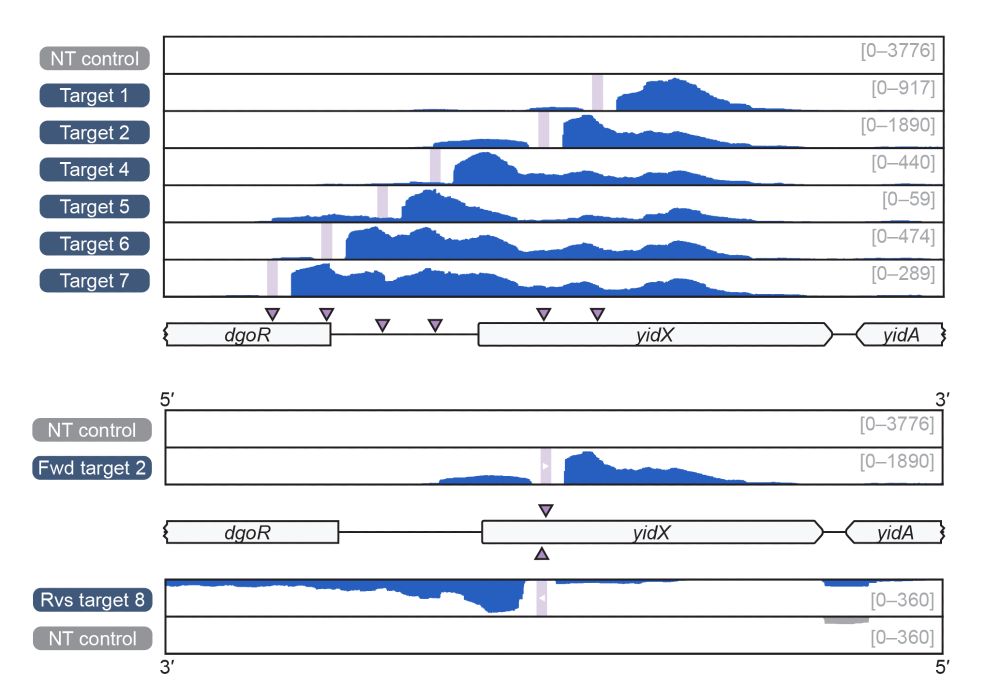
6/10 dCas12f-Sigma factors are able to recruit their native RNA polymerase (RNAP) to drive RNA-guided transcription at programmable sites. Remarkably, we were able to generate RNA (see RNA-seq) without relying on promoters in intergenic sequences, even within genes, and on either DNA strand.
11.06.2025 16:03 — 👍 5 🔁 2 💬 1 📌 1
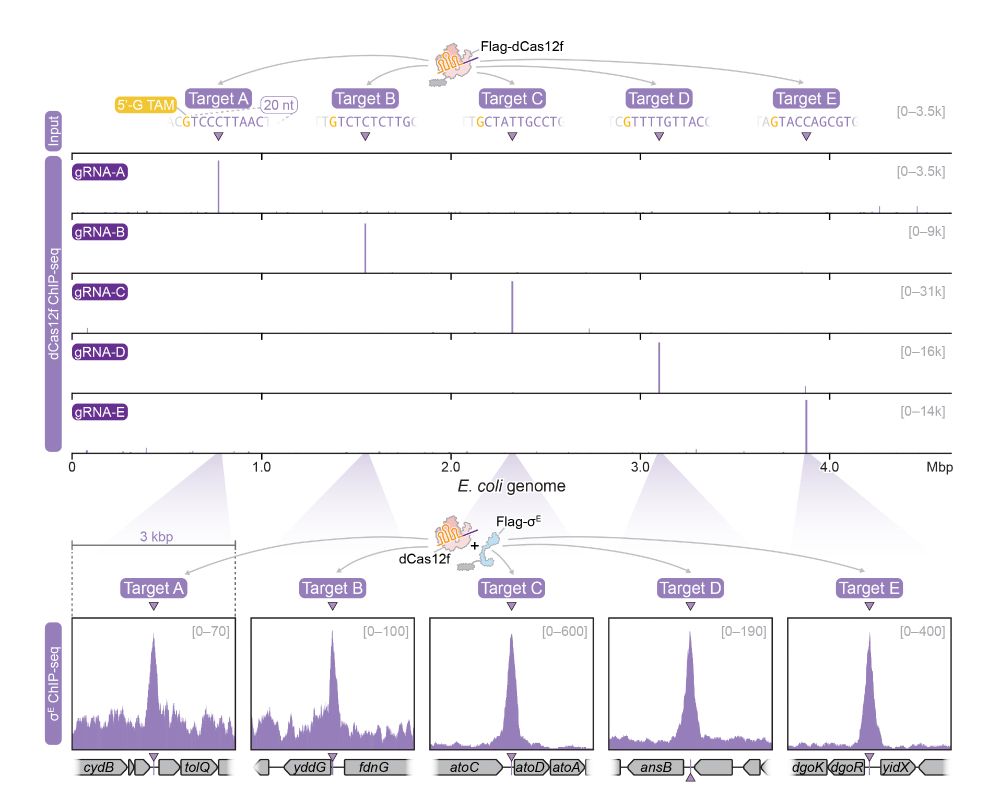
5/10 Indeed, when Cas12f is programmed to target various sites in the E. coli genome, we also observe recruitment of the Sigma factor to the same sites. dCas12f and Sigma appear to form a co-complex! Spoiler: check out our companion structure article with the Chang Lab!
11.06.2025 16:03 — 👍 2 🔁 0 💬 1 📌 0
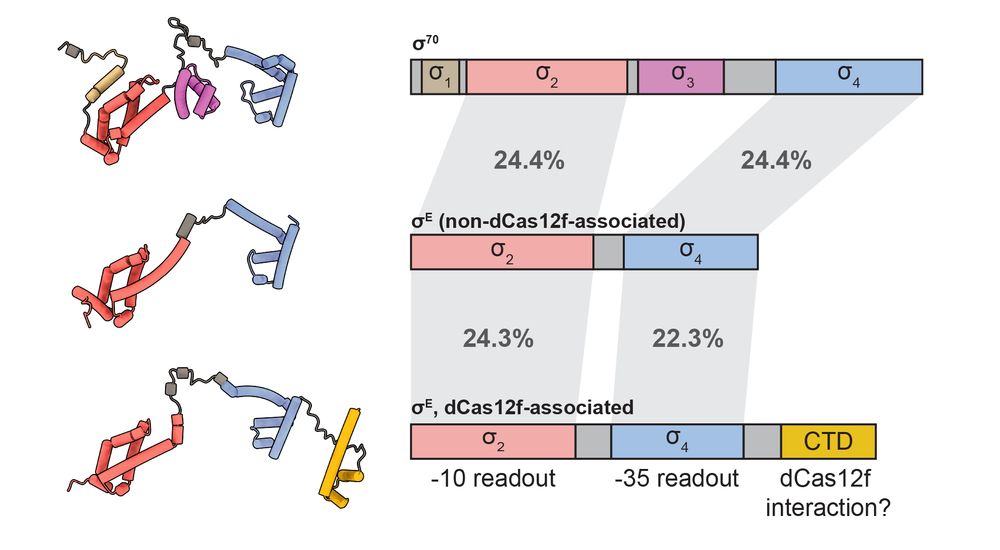
4/10 Sigma factors are essential for driving bacterial transcription by RNA polymerase (RNAP) from specific promoter sequence motifs. dCas12f-associated Sigma factors have an atypical, extended C-terminal domain, potentially facilitating interaction between Sigma and Cas12f.
11.06.2025 16:03 — 👍 2 🔁 1 💬 1 📌 0

3/10 The dead-Cas12f is highly compact (~370 aa) and binds a natural single-guide RNA (~90 nt). Strikingly, dCas12f has minimal PAM/TAM requirements. It can target custom sites flanked by a simple 5’-G nucleotide.
11.06.2025 16:03 — 👍 2 🔁 0 💬 1 📌 0
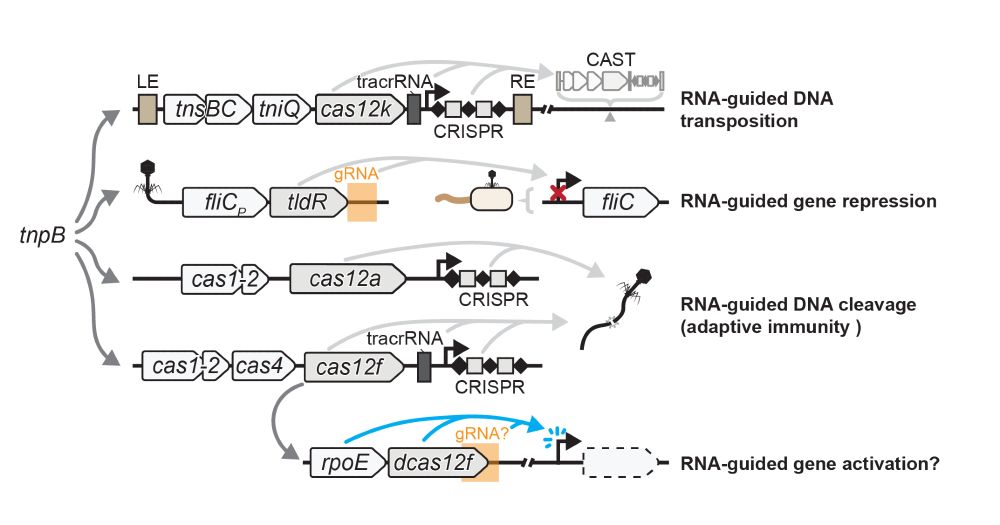
2/10 Cas proteins typically defend against bacterial viruses by cleaving their genomes. The Cas12f homologs we identified in bacteria (see also Altae-Tran et al. 2023) are nuclease-dead (dCas12f) and have a conserved association with SigmaE factors (RpoE), suggesting a new function.
11.06.2025 16:03 — 👍 3 🔁 2 💬 1 📌 0
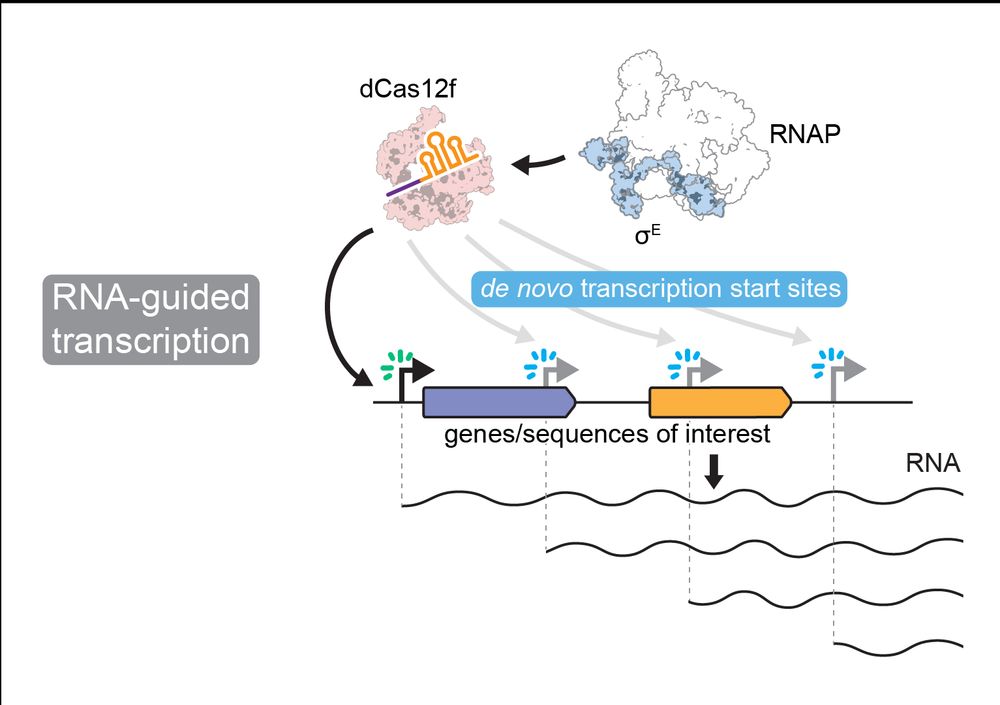
1/10 New pre-print(s) from the Sternberg Lab in collaboration with Leifu Chang's Lab! We uncover the unprecedented molecular mechanism of CRISPR-Cas12f-like proteins, which drive RNA-guided transcription independently of canonical promoter motifs.
Full story here:
www.biorxiv.org/content/10.1...
11.06.2025 16:03 — 👍 86 🔁 39 💬 3 📌 3
Science news from the medical university Karolinska Institutet (KI) in Sweden. Our vision is to advance knowledge about life and strive towards better health for all. https://ki.se/
Gene editing | Spatial-omics | Molecular medicine.
Post-doc with Schwank Lab, UZH Zurich. PhD from CRTD, Dresden.
Data Scientist Generative AI @BayerCropScience. ML for Plant Biology. PhD @IowaStateUniversity https://www.linkedin.com/in/koushik-nagasubramanian/
Plants, specialized metabolism, synthetic biology, protein evolution, and everything in between.
Postdoc at Sattley & Fordyce Labs, Stanford
Previously SynBio @ Voigt & Laub Labs, MIT
Evolutionary biologist (Multicellularity & social evolution). Prof. at Georgia Tech & Director of the QBioS PhD program.
https://ratclifflab.biosci.gatech.edu/
Jumping Genomics!
I run a lab in NYC that studies transposons 🧬in the brain 🧠
Opinions are all mine
mghlab.org
🔭🔬⚗️ Science Lover 📦🐈🧪⁉️
🍄Mycology and Infectious Diseases🦠
Research Engineer, PhD candidate 🧑🔬🧫🥼
ICVS, braga, Portugal 🇵🇹
Pasteur, Paris, France 🇫🇷
Sorbonne University, Paris, France 🇫🇷
Univ. François-Rabelais,Tours,France 🇫🇷
Biologist that navigate in the oceans of diversity through space-time
Protein evolution, metagenomics, AI/ML/DL
Website https://miangoaren.github.io/
Postdoc in the Genome Function Laboratory @crick.ac.uk | Functional Genomics, Protein Engineering, Synthetic Biology
🧬 Structural Bioinformatics | 💊 AI/ML for Drug Discovery | Geometric DL
🔬 @iocbprague.bsky.social, prev. PhD @cusbg.bsky.social @mff.unikarlova.cuni.cz
Principal Investigator | Microbial Molecular Genomics Lab | https://www.rousset-lab.com |International Center for Infectiology Research (CIRI) in Lyon 🇫🇷 Studying the molecular basis of phage-bacteria interactions.
Uses functional genomics to study astrocytes in neurodegenerative disease 🧪. Neuroscience PhD candidate at UCSF (Kampmann Lab). He/him 🏳️🌈
🏳️🌈 Harvard Neuro PhD student, Beth Stevens’ lab | Studying extrinsic regulators of astrocyte function | Herchel Smith, NSF, and HHMI Gilliam fellow
Incoming PhD student working on avian influenza | Interested in all things viruses & antiviral immunity | she/her 🔬🧬🦠
Interested in biophysical chemistry, single molecules, and nucleic acids. Into puns and speculative fiction.
Postdoc @Rueda Lab, MRC LMS.
He/him
Incoming Assistant Professor of MCDB at the University of Michigan. Former JCCF and Leading Edge Postdoc Fellow in the Aaron Whiteley lab at CU Boulder. Predatory bacteria and phage enthusiast obsessed with host-pathogen interactions. She/her.
Feminist and Scientist 👩🏽🔬🤔🧐 into Metabolism, mitochondria and mechanism. For banning guns, upholding democracy, repro rights, and police culture reform. WE are the resistance.
Asst. Prof. Uni Groningen 🇳🇱
Comp & Exp Biochemist, Protein Engineer, 'Would-be designer' (F. Arnold) | SynBio | HT Screens & Selections | Nucleic Acid Enzymes | Biocatalysis | Rstats & Datavis
https://www.fuerstlab.com
https://orcid.org/0000-0001-7720-9
Rubisco, protein engineering and photosynthesis. Starting a lab in the Cambridge biochemistry department this fall.
pryweslab.org
Assistant prof at VU Amsterdam; single-molecule biophysics; gene machines; #RNAvirus; #transcription; #replication; innate immunity
https://daviddulinlab.com/












